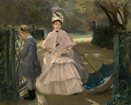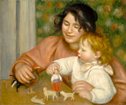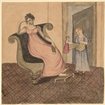









Paintings
Images below are in chronological order and sized approximately to scale relative to each other. *Click images to enlarge*
1. Portrait of Maria Salviati de'Medici with Giulia de'Medici
Artist: Pontormo, age about 43 (Italian; born 1494, died 1556)
Medium: Oil on panel, 35 x 28 inches
Location: Painted in Florence
Time: Painted in about 1537. The Americas were recently "discovered," Martin Luther had challenged Catholicism, and Copernicus had revealed that the earth revolved around the sun instead of vice versa. At this time Pontormo had been an unofficial painter for the Medici for 23 years.
Woman subject: The woman is Maria Salviati de'Medici and the girl is Giulia de'Medici. Guilia's father was the illegitimate son of a Medici cardinal and an African servant. When Pontormo painted this portrait, Guilia's father had just been murdered and Maria had taken the girl into her care. Maria also had a teenaged son, Cosimo, who would later become the powerful Grand Duke of Tuscany.
Things to notice: The figure of Guilia was painted over sometime in the 19th century and rediscovered when the painting was cleaned. Maria's elongated fingers are typical of paintings done in the Mannerist style.
2. Nanny and child
*Woman artist*
Artist: Eva Gonzalès, age 29 (French; born 1849, died 1883)
Medium: Oil on canvas, 26 x 32 inches
Location: Painted in Paris
Time: Painted in 1877-1878, during the French Third Republic established in 1870 that continued until World War II. Gonzalès would marry engraver Henri Guérard a year later, and then die from complications after childbirth four years after that.
Woman subject: The nanny is Gonzalès' sister Jeanne, whom she often used as a model.
Things to notice: Gonzalès uses blue tones as a compositional technique to frame the central figure. Her signature "Eva Gonzalès" appears along the bottom rail of the fence gate. Her work is usually characterized as Realist or Impressionist.
Additional information: Gonzalès modeled for the artist Edouard Manet and eventually became his formal pupil. The Realist and Impressionist art movements both were characterized by the exploration of genre scenes as subjects. This trend gave women artists more opportunities. Previously, professional artists had emphasized history painting, which necessitated a knowledge of anatomy that women weren't allowed to acquire.
3. Child with toys -- Gabrielle and the artist's son, Jean
Artist: Auguste Renoir, age 55 (French; born 1841, died 1919)
Medium: Oil on canvas, 21 x 26 inches
Location: Painted in Paris
Time: Painted in 1895-1896, during the French Third Republic. At this point, Renoir had been a financially successful artist for about fifteen years.
Woman subject: The woman is Gabrielle Renard, a frequent model for Renoir; the boy is Renoir's second son, Jean. Renoir painted several paintings of Gabrielle and Jean in this time period.
Things to notice: Renoir started using more red in his paintings in the 1890s because he noticed that the red had faded from his earlier paintings. Renoir was one of the leaders of the Paris Impressionists.
Other works (prints, drawings, and a small oil painting)
Images below are in chronological order and sized approximately to scale relative to each other (three times the scale of the painting images above). *Click images to enlarge*
4. Mother with two children
Artist: Adriaen van Ostade, age about 65 (Dutch; born 1610, died 1685)
Medium: Etching, 3.6 x 2.8 inches
Location: Made in Haarlem, Holland
Time: Printed in about 1675, during the Dutch War. During 1672, Van Ostade had fled Haarlem for Amsterdam when France invaded. Van Ostade was a successful artist by this time. He was also wealthy due to his inheritance from his father-in-law and his wife after the latter's death in 1666.
Woman subject: The identities of the subjects are not known, but they appear to be peasants. Peasant genre paintings were Van Ostade's specialty; many of his etching compositions echo his paintings.
Things to notice: This is an etching from Van Ostade's later period. His later etching style is systematic rather than sketchy, as evidenced by the cross-hatching in this example.
5. Mother and child
*Woman artist*
Artist: Angelica Kauffman [also: Kauffmann], age unknown, possibly 22-24 (Swiss; born 1741, died 1807)
Medium: Etching, 5.6 x 4.4 inches
Location: Possibly made in Rome (see below)
Time: Possibly made sometime in 1763-1765, while Kauffman was in Rome and before she traveled to London: this was a period in which she created several etchings.
Woman subject: The identities of the subjects are not known.
Things to notice: Notice the cross-hatching and stippling techniques on the faces. Compare this etching side-by-side with the Van Ostade etching. How do the differences in technique and composition influence how the works impact you as the viewer?
Additional information: Kauffman began as a portrait painter and eventually became a history painter in the Neoclassical style. She was very successful and a leader of the Neoclassicism movement in England. Women generally didn't become history painters because they weren't permitted to study anatomy. Kauffman worked from statues of nudes. She was one of two women among the forty founding members of the London Royal Academy of Arts (RA) in 1768 (with Mary Moser). The RA didn't admit any additional women members until the 20th century. Kauffman's father was a minor painter who encouraged her artistic ambitions. This may have helped her overcome the social and institutional barriers to women artists. However, women artists in Kauffman's time were regarded as amateurs purely on the basis of gender, regardless of ability. It was largely Kauffman's personal determination that brought her professional status.
6. Mother with her son and a pony
Artist: Agostino Brunias, age about 47 (Italian; born 1728, died 1796)
Medium: Oil on canvas, 13.0 x 11.0 inches
Location: Painted in the Lesser Antilles
Time: Painted in about 1775, five years after itinerant professional artist Brunias arrived in the Caribbean. The Caribbean became a trading post in the 16th century; Europeans obtained slaves from West Africa and established sugar plantations in the mid-17th century. In the 1700s, planters patronized the arts by bringing over artists from Europe to paint local scenes.
Woman subject: The identities of the subjects are not known.
Things to notice: Brunias often painted enslaved black people and free mixed-race people in the Lesser Antilles. The dark-skinned woman in this painting wears ornate jewelry, but she and her son have bare feet. Notice the tiny dog.
7. Mother and child
*Woman artist*
Artist: Eunice Pinney, age about 45 (American; born 1770, died 1849)
Medium: Drawing, pen and black ink and watercolor, 9.9 x 9.9 inches
Location: Made in Connecticut
Time: Made in about 1815. James Madison was president of the United States. A self-taught watercolorist, Pinney had been painting for six years at this point.
Woman subject: The identities of the subjects are unknown.
Things to notice: In this drawing, the seemingly mundane domestic scene is complicated by the negative body language of the mother. The tension is heightened by the intensity of the geometric floor design. Pinney is the earliest known American Naïve watercolorist.
Additional information: In the 18th and 19th centuries, upper class American women were expected to be able to draw and paint. A modest degree of proficiency in these accomplishments were part of a lady's repertoire, along with needlework, and a way for her to fill her leisure time between domestic obligations. Only a very few women pursued art as a profession in the early 19th century. Pinney was not one of these. Until the mid-19th century, even dedicated women artists usually thought of themselves as amateurs, due to lack of opportunities for formal training. Pinney's subject choices, the skill and confidence of her compositions, and her use of color were unconventional and exceptional.
8. Woman and child
*Gender of artist is unknown*
Artist: Artist unknown (Indian)
Medium: Drawing, opaque and transparent watercolor on paper, 9.8 x 7.1 inches
Location: Made in Kolkata (i.e. Calcutta)
Time: Made in the early to mid-19th century, around the time that the British made Kolkata the capital of British India. In the past, artists were born as such into hereditary castes. They had a low social status and were largely controlled by patrons. In the 1800s, the European concept of art for its own sake changed the social view of artists. Indian artists began to use art to explore and express their traditions.
Woman subject: The identities of the subjects are unknown.
Things to notice: The child grasps the woman's extended forefinger; the woman's other forefinger is also extended, perhaps to brush back her long wavy hair. The figures, both naked, wear similar ornaments on their foreheads, ears, and around their necks and wrists. Compare this watercolor drawing side-by-side with the one by Pinney, a woman artist. Do you think the Indian artist was a man or a woman?
9. Mother and child
Artist: Ogata Gekkō, age around 25-35 (Japanese; born 1859, died 1920)
Medium: Color woodcut print, 14.5 x 9.9 inches
Location: Made in Japan
Time: Printed in the late 19th century, during the reign of Emperor Meiji. Japan reopened to the Western world after 200 years of isolation. Influenced by Western realism in art, traditional ukiyoe evolved into prints illustrating current events. Gekkō printed notable triptychs of the Sino-Japanese War (1894-1895). This print is part of his "Customs of Women" series.
Woman subject: The identities of the subjects are not known.
Things to notice: The red seal near the bottom left of the print is probably Gekkō's signature. Notice the Western-style architectural colonnade that dominates the print.Compare this work, depicting a mother and child in late 19th century Japan, side-by-side with depictions of the same theme by Brunias (late 18th century Caribbean) and Pinney (early 19th century United States). What do the works tell you about relationships between mothers and children in these different times and places?
10. Mother and child
Artist: Otto Müller, age about 46 (German; born 1874, died 1930)
Medium: Lithograph, 13.9 x 10.4 inches
Location: Made in Germany (now Poland)
Time: Printed around 1920. Müller finished his World War I military service in 1918 and became a professor at the Academy of Fine Arts in Breslau (i.e. Wrocław) in 1919.
Woman subject: The identities of the subjects are not known.
Things to notice: Müller was a member of the Die Brücke ("The Bridge"), a group of artists seeking to connect Primitivist art and the actual art of indigenous peoples to a future unified style of art. They were reacting against the recent contemporary aesthetics of Realism and Impressionism. Müller's two-dimensional approach and monochromatic palette reflect this philosophy.
Image sources:
1. Pontormo. Portrait of Maria Salviati de'Medici with Giulia de'Medici. Painting. The Walters Art Museum. Baltimore. 19 Dec. 2013. http://thewalters.org/
2. Gonzalès, Eva. Nanny and child. Painting. National Gallery of Art. Washington. 3 Jan. 2014. https://images.nga.gov/
3. Renoir, Auguste. Child with toys -- Gabrielle and the artist's son, Jean. Painting. National Gallery of Art. Washington. 7 Jan. 2014. https://images.nga.gov/
4. Ostade, Adriaen van. Mother with two children. Print. Los Angeles County Museum of Art (LACMA). Los Angeles. 19 Dec. 2013. http://www.lacma.org/
5. Kauffman, Angelica. Mother and child. Print. Yale Center for British Art. New Haven. 19 Dec. 2013. http://britishart.yale.edu/
6. Brunias, Agostino. Mother with her son and a pony. Painting. Yale Center for British Art. New Haven. 3 Jan. 2014. http://britishart.yale.edu/
7. Pinney, Eunice. Mother and child. Drawing. National Gallery of Art. Washington. 3 Jan. 2014. https://images.nga.gov/
8. Woman and child. Drawing. Los Angeles County Museum of Art (LACMA). Los Angeles. 3 Jan. 2014. http://www.lacma.org/
9. Gekkō, Ogata. Mother and child. Print. Los Angeles County Museum of Art (LACMA). Los Angeles. 7 Jan. 2014. http://www.lacma.org/
10. Müller, Otto. Mother and child. Print. National Gallery of Art. Washington. 7 Jan. 2014. https://images.nga.gov/